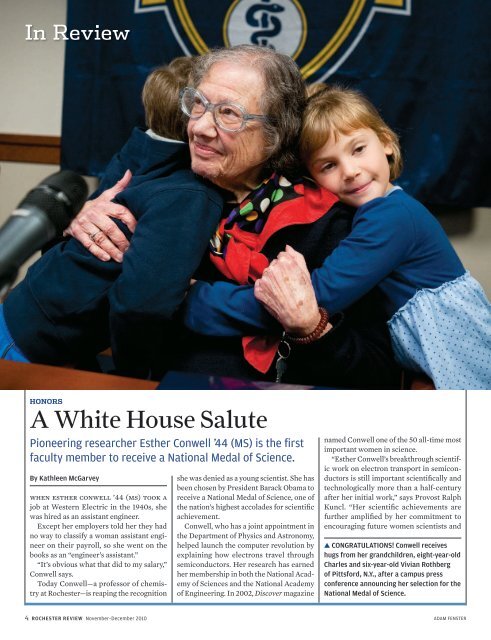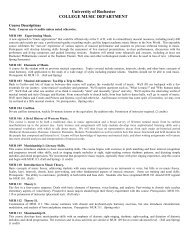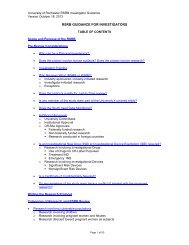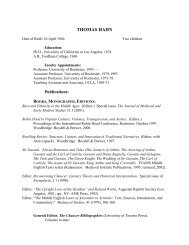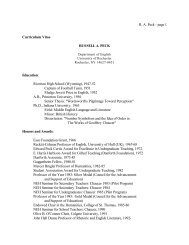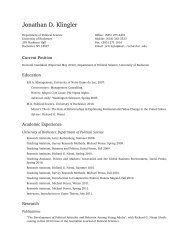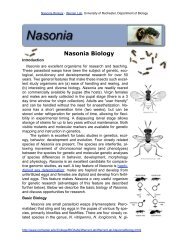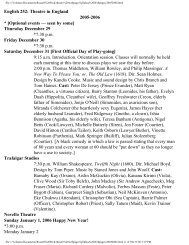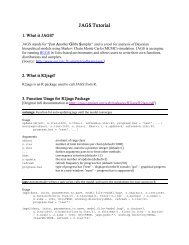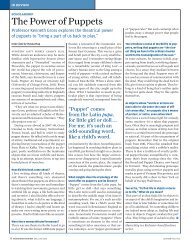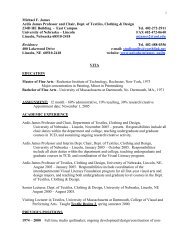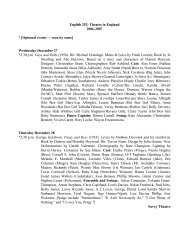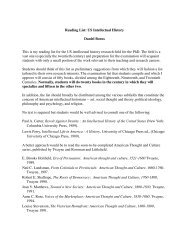A White House Salute - University of Rochester
A White House Salute - University of Rochester
A White House Salute - University of Rochester
You also want an ePaper? Increase the reach of your titles
YUMPU automatically turns print PDFs into web optimized ePapers that Google loves.
In Review<br />
Honors<br />
A <strong>White</strong> <strong>House</strong> <strong>Salute</strong><br />
Pioneering researcher esther Conwell ’44 (ms) is the first<br />
faculty member to receive a National medal <strong>of</strong> science.<br />
By Kathleen McGarvey<br />
When Esther Conwell ’44 (MS) took a<br />
job at Western Electric in the 1940s, she<br />
was hired as an assistant engineer.<br />
Except her employers told her they had<br />
no way to classify a woman assistant engineer<br />
on their payroll, so she went on the<br />
books as an “engineer’s assistant.”<br />
“It’s obvious what that did to my salary,”<br />
Conwell says.<br />
Today Conwell—a pr<strong>of</strong>essor <strong>of</strong> chemistry<br />
at <strong>Rochester</strong>—is reaping the recognition<br />
she was denied as a young scientist. She has<br />
been chosen by President Barack Obama to<br />
receive a National Medal <strong>of</strong> Science, one <strong>of</strong><br />
the nation’s highest accolades for scientific<br />
achievement.<br />
Conwell, who has a joint appointment in<br />
the Department <strong>of</strong> Physics and Astronomy,<br />
helped launch the computer revolution by<br />
explaining how electrons travel through<br />
semiconductors. Her research has earned<br />
her membership in both the National Academy<br />
<strong>of</strong> Sciences and the National Academy<br />
<strong>of</strong> Engineering. In 2002, Discover magazine<br />
named Conwell one <strong>of</strong> the 50 all-time most<br />
important women in science.<br />
“Esther Conwell’s breakthrough scientific<br />
work on electron transport in semiconductors<br />
is still important scientifically and<br />
technologically more than a half-century<br />
after her initial work,” says Provost Ralph<br />
Kuncl. “Her scientific achievements are<br />
further amplified by her commitment to<br />
encouraging future women scientists and<br />
u CONGRATULATIONS! Conwell receives<br />
hugs from her grandchildren, eight-year-old<br />
Charles and six-year-old Vivian Rothberg<br />
<strong>of</strong> Pittsford, N.Y., after a campus press<br />
conference announcing her selection for the<br />
National Medal <strong>of</strong> Science.<br />
4 ROCHESTER REVIEW November–December 2010 ADAm FeNster
mentoring the next generation <strong>of</strong> scientific<br />
leaders. We are indebted to her for her<br />
crucial contributions to our nation’s scientific<br />
development, and delighted to call her<br />
a colleague.”<br />
Conwell—who, at the age <strong>of</strong> 88, still<br />
maintains a daily presence in the chemistry<br />
department, where she’s currently studying<br />
the movement <strong>of</strong> electrons through DNA—<br />
was born in the Bronx and raised in Brooklyn.<br />
She showed an early aptitude for math<br />
and a love for discipline and challenge.<br />
She became a physics major as an undergraduate<br />
at Brooklyn College (now part <strong>of</strong><br />
the City <strong>University</strong> <strong>of</strong> New York) and came<br />
to <strong>Rochester</strong> in 1942, a 20-year-old ready to<br />
work on her doctorate.<br />
But soon after her arrival many <strong>of</strong> <strong>Rochester</strong>’s<br />
physicists had left campus to pursue<br />
research for the government in World<br />
War II. After a year’s study, Conwell took<br />
her master’s degree—under quantum mechanics<br />
theorist Victor Weisskopf—and<br />
produced with him what is today known as<br />
the Conwell-Weisskopf theory, which described<br />
how “impurity ions” impede the<br />
flow <strong>of</strong> electrons and led to a better understanding<br />
<strong>of</strong> the materials used in making<br />
transistors and integrated circuits.<br />
Conwell continued her studies at the<br />
<strong>University</strong> <strong>of</strong> Chicago, where she worked<br />
under 1983 Nobel Prize winner Subrahmanyan<br />
Chandrasekhar and earned a doctorate<br />
in physics in 1948.<br />
She embarked on a career in industry,<br />
working at Bell Telephone Laboratories in<br />
the early 1950s, then at GTE Laboratories<br />
until 1972, and at Xerox Corp. from 1972<br />
until 1998.<br />
First serving as an adjunct pr<strong>of</strong>essor at<br />
<strong>Rochester</strong> in 1990, Conwell became a fulltime<br />
member <strong>of</strong> the faculty in 1998, after<br />
her retirement from Xerox.<br />
“Esther’s 70-year-long and still active<br />
career has greatly contributed to the technological<br />
revolution,” says Robert Boeck-<br />
man, the Marshall D. Gates Jr. Pr<strong>of</strong>essor <strong>of</strong><br />
Chemistry and the chair <strong>of</strong> the chemistry<br />
department, who calls the National Science<br />
Award the “ultimate recognition a U.S. scientist<br />
or engineer can achieve.” Her work<br />
has “directly led to the practical devices we<br />
use every day.”<br />
While women have made great strides in<br />
the sciences, Conwell says, there’s “still a<br />
long way to go.”<br />
She has done what she can to close the<br />
gap, her efforts earning her the 2008 American<br />
Chemical Society Award for Encouraging<br />
Women into Careers in the Chemical<br />
Sciences. The society recognized Conwell<br />
for her own career accomplishments and<br />
for her “unwavering dedication to and advocacy<br />
on behalf <strong>of</strong> women in chemistry<br />
and chemical engineering.”<br />
“You have to work harder than a man<br />
Conwell took her master’s degree<br />
under quantum mechanics theorist<br />
Victor Weisskopf and produced with him<br />
what is today known as the Conwell-Weisskopf<br />
theory, which led to a better understanding<br />
<strong>of</strong> the materials used in making transistors<br />
and integrated circuits.<br />
to get to the same kind <strong>of</strong> job, but it’s a lot<br />
more possible now,” says Conwell, who recently<br />
celebrated her 65th anniversary with<br />
husband Abraham Rothberg and works<br />
alongside their son, Lewis Rothberg, a pr<strong>of</strong>essor<br />
<strong>of</strong> chemistry at <strong>Rochester</strong>.<br />
The National Medal <strong>of</strong> Science was<br />
established by Congress in 1959 and is<br />
awarded by the president to recognize<br />
“outstanding contributions to knowledge<br />
in the sciences.” A committee <strong>of</strong> 12 scientists<br />
and engineers, appointed by the chief<br />
executive, nominates individuals for the<br />
award, but the final decisions are made by<br />
the president.<br />
Conwell calls the award a “humbling<br />
gift,” and she met the attention surrounding<br />
the news with both modesty and the commitment<br />
to hard work that has propelled<br />
her through her career.<br />
As Conwell sat beside him at the postannouncement<br />
press conference, Boeckman<br />
revealed that she had commented to<br />
him about the hoopla, “You know, all this is<br />
doing is preventing me from finishing my<br />
next paper.”r<br />
Who Has Won<br />
a National Medal?<br />
In RevIew<br />
Conwell is the first <strong>Rochester</strong> faculty<br />
member to receive a National Medal <strong>of</strong><br />
Science, joining several alumni who have<br />
earned national medals for their work.<br />
NatioNal Medal <strong>of</strong> ScieNce<br />
1986: d. a. Henderson ’54M (MD), ’77<br />
(Honorary), a longtime faculty member at<br />
Johns Hopkins <strong>University</strong>, was honored for<br />
leading the team that eradicated smallpox<br />
as a disease in humans.<br />
2003: John Prausnitz ’51 (MS), a<br />
pr<strong>of</strong>essor <strong>of</strong> chemical engineering at the<br />
<strong>University</strong> <strong>of</strong> California at Berkeley and<br />
a senior scientist at Lawrence Berkeley<br />
National Laboratory, was recognized for<br />
improving the design <strong>of</strong> large chemical<br />
plants to make them safer, more efficient,<br />
and more environmentally friendly.<br />
NatioNal Medal <strong>of</strong> freedoM<br />
2002: Henderson was honored for his<br />
return to federal service after September<br />
11, 2001, to help with anti-bioterrorism<br />
efforts.<br />
NatioNal Medal <strong>of</strong><br />
tecHNology aNd iNNovatioN<br />
1995: alejandro Zaffaroni ’49M (PhD),<br />
’51M (Flw), ’72 (Honorary), who through<br />
his career in industry is associated with<br />
the invention <strong>of</strong> the birth control pill, the<br />
“patch,” and controlled drug delivery,<br />
was recognized for his contributions to<br />
the pharmaceutical and biotechnology<br />
industries.<br />
2005: dace viceps Madore ’69 and Maya<br />
Koster ’82 were chosen as part <strong>of</strong> a fourperson<br />
team from Wyeth Pharmaceuticals<br />
credited with developing the children’s<br />
vaccine Prevnar, which helps prevent<br />
invasive pneumococcal disease—a vaccine<br />
based on technology developed by<br />
Medical Center scientists David Smith,<br />
Porter Anderson, and Richard Insel.<br />
NatioNal Medal <strong>of</strong> tHe artS<br />
1995: david diamond ’37E, who left<br />
<strong>Rochester</strong> before completing his degree,<br />
received the medal in recognition <strong>of</strong> his<br />
achievements as a composer.<br />
—Kathleen McGarvey<br />
November–December 2010 ROCHESTER REVIEW 5


